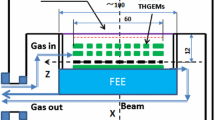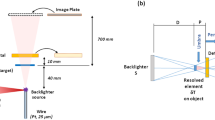Abstract
Introduction
THick Gas Electron Multiplier (THGEM) is considered in many UV photon detector applications. It has the capability of detecting single photon and imaging with high sensitivity. Operating parameters such as choice of gas mixture, pressure, drift field, drift gap, multiplication voltage, induction field and induction gap play an important role in deciding the spatial resolution of the detector. Detailed simulation study enables to optimize the above-mentioned parameters for a given THGEM-based imaging detector and hence to achieve improved performance for the same.
Materials and methods
Simulation, using ANSYS and Garfield++, starts with the release of primary electrons at random coordinates on the photocathode plane. They are tracked as they pass through the drift gap and THGEM hole till the electron cloud reaches anode plane. Distribution of electron cloud on the anode plane along X and Y axis is plotted in histogram and fitted with Gaussian function to determine spatial resolution. Ar/CO2 (70:30) mixture, which shows higher ETE and lower transverse diffusion, is chosen for this simulation study.
Conclusion
Transverse diffusion has a major impact on both ETE and the spatial resolution. Lower transverse diffusion coefficient is always desired for having better resolution as well as for ETE. It is found from the simulation study that higher gas pressure, lower drift field and induction field, smaller drift and induction gap can provide optimum detection efficiency with the best spatial resolution. The simulation method proposed here can also be extended to X-ray imaging detectors.










Similar content being viewed by others
References
F. Sauli, Nucl. Instrum. Methods Phys. Res. A 477(1), 1–7 (2002)
R. Chechik et al., Nucl. Instrum. Methods Phys. Res. A 535(1), 303–308 (2004)
A.F. Buzulutskov, Instrum. Exper. Tech. 50(3), 287–310 (2007)
M. Cortesi et al., J. Instrum. 8(10), C10009 (2013)
F. Sauli, Nucl. Instrum. Methods Phys. Res. A 386(2–3), 531–534 (1997)
F. Tessarotto, Evolution and recent developments of the gaseous photon detectors technologies. In: Nuclear Instruments and Methods in Physics Research Section A: Accelerators, Spectrometers, Detectors and Associated Equipment (2017). https://doi.org/10.1016/j.nima.2017.11.081
R. Chechik et al., Nucl. Instrum. Methods Phys. Res. A 553(1), 35–40 (2005)
M. Alexeev et al., Nucl. Instrum. Methods Phys. Res. A 732, 264–268 (2013)
R. Chechik et al., Nucl. Instrum. Methods Phys. Res. A 595(1), 116–127 (2008)
A. Di Mauro, Nucl. Instrum. Methods Phys. Res. A 766, 126–132 (2014)
C. Shalem et al., Nucl. Instrum. Methods Phys. Res. A 558(2), 475–489 (2006)
J.M. Maia et al., Nucl. Instrum. Methods Phys. Res. A 580(1), 373–376 (2007)
A. Bamberger et al., Nucl. Instrum. Methods Phys. Res. A 572(1), 157–159 (2007)
M. Cortesi et al., J. Instrum. 2(09), P09002 (2007)
V.N. Kudryavtsev et al., Nucl. Instrum. Methods Phys. Res. A 845, 289–292 (2017)
Y. Lan-Lan et al., arXiv preprint arXiv:1306.0270 (2013)
H. Zhao et al., Radiat. Detect. Technol Methods 1(1), 6 (2017)
Ansys, https://www.ansys.com
G. Baishali et al., Nucl. Instrum. Methods Phys. Res. A 729, 51–57 (2013)
http://garfieldpp.web.cern.ch/garfieldpp/. Accessed Mar 2016
C.D.R. Azevedo et al., J. Instrum. 11(08), P08018 (2016)
L. Moleri et al., On the localization properties of an RPWELL gas-avalanche detector. J Instrum 12(10), P10017 (2017)
Y. Assran, A. Sharma, arXiv preprint arXiv:1110.6761 (2011)
A. Breskin, Nucl. Instrum. Methods Phys. Res. A 367(1-3), 326–331 (1995)
A. Breskin et al., Nucl. Instrum. Methods Phys. Res. A 478(1–2), 225–229 (2002)
C. Shalem, M.Sc. thesis, Weizmann Institute of Science. http://jinst.sissa.it/jinst/theses/2005_JINST_TH_001.pdfS
Author information
Authors and Affiliations
Corresponding author
Rights and permissions
About this article
Cite this article
Ray, P., Baishali, G., Radhakrishna, V. et al. Spatial resolution optimization in a THGEM-based UV photon detector. Radiat Detect Technol Methods 2, 39 (2018). https://doi.org/10.1007/s41605-018-0070-2
Received:
Revised:
Accepted:
Published:
DOI: https://doi.org/10.1007/s41605-018-0070-2




